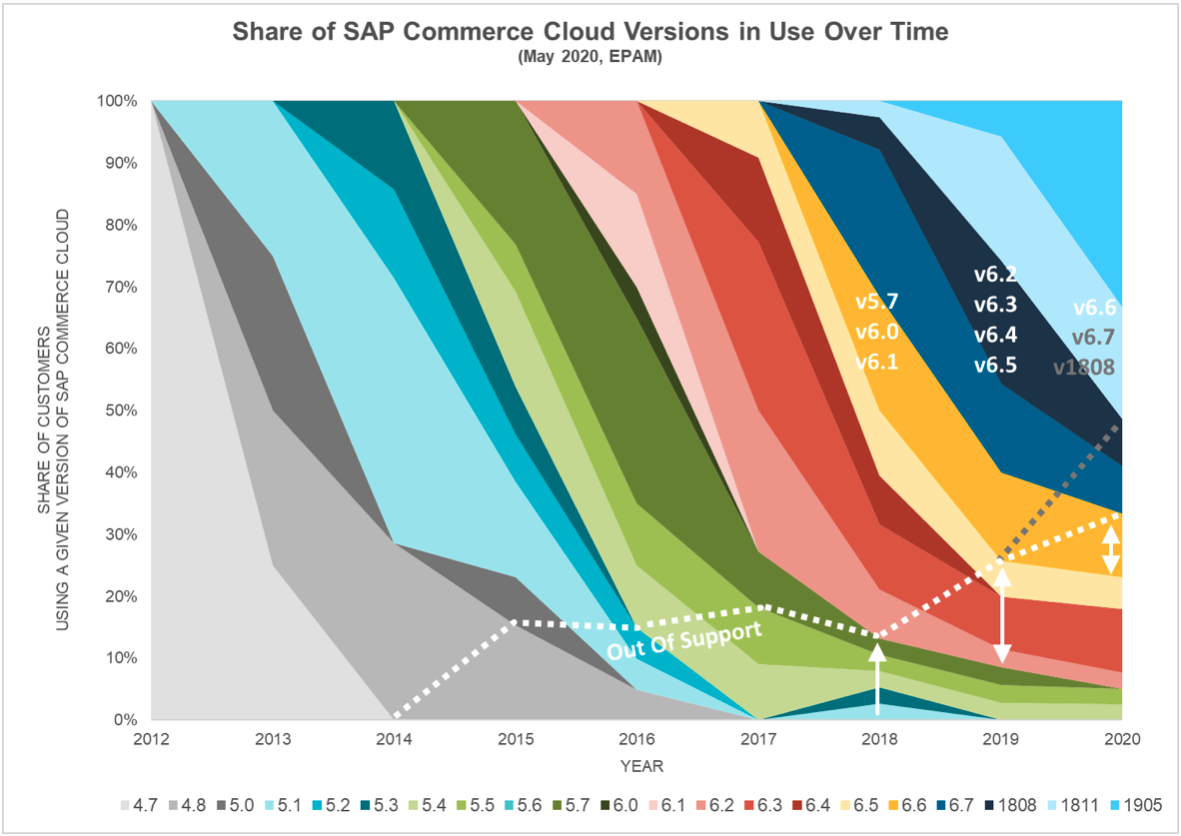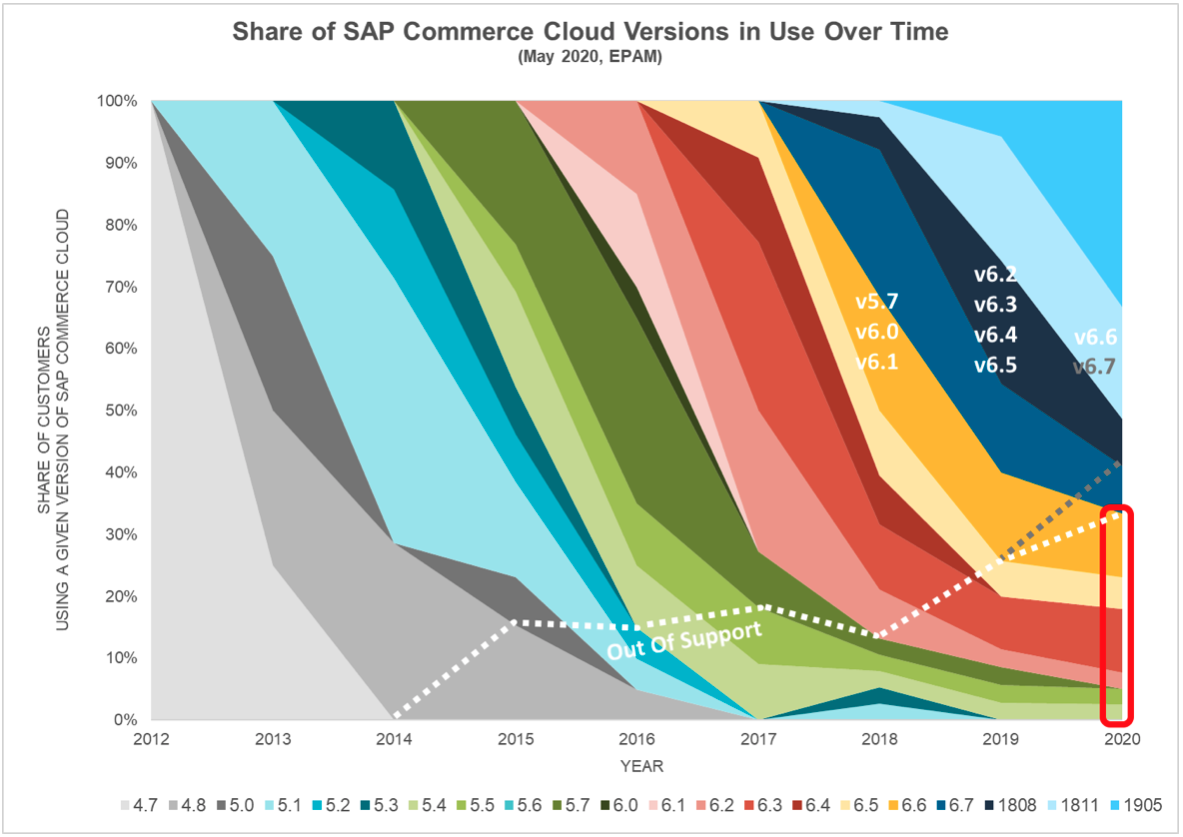What Does History Tell Us About The Upgrade Potential Of The Pending SAP Commerce Cloud v2005 Release? — Part 2
In my previous article (part 1) I looked at the history of SAP Commerce Cloud (Hybris) versions and did some analysis regarding how Hybris solution owners upgraded (or not) to newer versions over time. The underlying theme was to ascertain how v2005 might be received.
v2005 has now been released and SAP’s release notes make mention of new end of life dates for v1808, v1811, & v1905 as follows:

Let’s see how that impacts my previous commentary regarding the end of life, found in the “Does the SAP support lifecycle drive upgrades?” and “Never Say Die” sections of part 1 of this blog entry.
Here was the original graph:

Here is the revised graph based on the new end of life dates:

Adjusting for the new end of life dates, you can see that the grey dotted line, representing versions that will go out of support in 2020, shifts downwards as a result of the support extension for v1808.
Previously, I wrote about the fact that about 35% of the data set was operating outside of support. That number rose to around 45% of the data set if we also included v6.7 and v1808, which were originally scheduled to go out of support later this year. With the revised end of life dates, the number of Hybris solution owners operating outside of support or at risk of operating outside of support by year end (assuming no upgrade actions are taken) drops from ~45% to ~40%.
What do we make of this?
Well, my initial reaction is that someone from within SAP ran a dataset similar to mine and reached the same conclusions that I wrote about earlier. That is, Hybris solution owners are falling behind on their upgrades and therefore SAP forcing their hands isn’t going to win SAP any friends. Granting an extension may give numerous Hybris solution owners the runway needed to get the task done. This is even more true in the COVID-19 era when business has been upended and budgets slashed. The last thing many companies want to do right now is to do a technical upgrade of their e-commerce platform when they’re simply trying to figure out how to stay afloat for the next quarter.
But let’s take a look at it from another angle. Even with the adjusted end of life dates, SAP still only has 4 versions to maintain until August 29, 2021, which is when v1808, v1811, and v1905 will now all simultaneously go out of support. At that point, v2005 and, presumably, v2105, would be the only two versions left in support. Rewind a few years to, for example, 2018, and you see that SAP was maintaining upwards of 8 different versions. Each of those is a cost to maintain. Ergo, even though SAP is doing the community a “favour” by extending the end of life on v1808 and newer versions, they are actually on a downward trend with respect to their overall support costs, facilitated by the fact that they have moved from 3-4 releases per year to 1 per year.
Why v1808 and not v6.7?
One curious thing about the altered end of life dates is that v1808, v1811, and v1905 all had their end of life dates changed; however, v6.7 did not. Why not?
Or, framed another way, why not adjust v1811 and v1905 but lump v1808 in with v6.7 and leave the end of life date on both unchanged?
Part of the answer undoubtedly lies in the aforementioned cost argument. However, there are likely others. For starters, v6.7 is only a few months away from end of life at this point in time. To suddenly change that end of life date would potentially upend numerous Hybris solution owners who are mid-upgrade or just about to start. If the version they are on now has extended shelf life, then that undermines the business case for upgrading, momentum SAP likely does not want to disrupt. Conversely, for those on v1808, thoughts of upgrading hadn’t likely surfaced just yet, since that deadline was still at least 7 months away. For those that might have engaged in some advanced planning, dreams of upgrading early likely got shelved as soon as the COVID-19 crisis hit and budgets were slashed.
SAP may also have some strategic reasons for axing v6.7 while tolerating the continuation of v1808. During a recent “New Feature Highlights” presentation I attended that SAP gave to one of my clients, SAP exhibited a table showcasing the various “major” features/subsystems of Hybris against various Hybris versions. For each cell in the table, they noted whether a feature/subsystem had been added, upgraded, left alone, deprecated, etc. This table called out “SAP Integration APIs” and “Context Driven Services Integration” as two features flagged as, “OOTB feature was added to commerce in this release” for v1808. Now, if we think to the major competitive challenges Hybris is facing despite its dominant position in e-commerce, it’s heritage as a “monolith” and the market’s emphasis on personalization as a way to increase online sales are two key ones. The APIs help further open up Hybris to “API first” and micrservice based architectures, thereby helping to further beat down the old “monolith” noose around Hybris’s neck. Context Driven Services Integration ensures that personalization is at Hybris solution owners’ fingertips if/when they need it (not to mention additional licence revenue for SAP). By ensuring that v1808 is the minimally supported version out there, SAP consequently ensures that it’s customer base is in a position to adopt these two key features, and therefore better argue against any suggestions that an alternative e-commerce platform may be better suited for the e-commerce challenges of 2020 and beyond.
